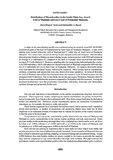| dc.contributor.author | Yasin, Abdul Hamid | |
| dc.contributor.author | Razak, Solahuddin A. | |
| dc.date.accessioned | 2018-12-06T07:54:20Z | |
| dc.date.available | 2018-12-06T07:54:20Z | |
| dc.date.issued | 1999 | |
| dc.identifier.citation | Yasin, A. H., & Razak, S. A. (1999). Distribution of macrobenthos in the South China Sea, Area I: Gulf of Thailand and east coast of Peninsular Malaysia. In Proceedings of the First Technical Seminar on Marine Fishery Resources Survey in the South China Sea, Area I: Gulf of Thailand and Peninsular Malaysia, 24-26 November 1997, Bangkok, Thailand (pp. 285-293). Samutprakan, Thailand: Training Department, Southeast Asian Fisheries Development Center. | en |
| dc.identifier.uri | http://hdl.handle.net/20.500.12067/790 | |
| dc.description.abstract | A study on the macrobenthos profile was conducted using the research vessel MV SEAFDEC in almost all parts of the Gulf of Thailand and the East Coast of Peninsular Malaysia. A total of 44 stations were located within the Gulf of Thailand and 37 within that of East Coast of Peninsular Malaysia. Two cruises were carried out during the pre-and post-north-east monsoon. Macrobenthos showed greater density in Malaysian waters during the pre-monsoon period with 2500 individuals (at an average 67.6 individuals/m2) compared to the Gulf of Thailand which showed 860 individuals (average 19.5 individuals/m2). However, sampling after the monsoon has indicated quite the reverse, with 2680 individuals (60.9 individuals/m2) found in the Gulf of Thailand compared to 620 individuals (16.8 individuals/m2) in the East Coast of Peninsular Malaysia. All samples from both cruises were dominated by polychaete worms, followed by crustacea. Other groups such as echinoderms, molluscs, nemertians and sipunculids were also observed in lesser quantities. In terms of diversity, the Gulf of Thailand showed less families/taxa before the monsoon (with 20 families) than after the monsoon (with 35 families). The reverse holds true for the east coast of Peninsular Malaysia when 33 families were uncovered before the monsoon compared to 26 families after the monsoon. Among the dominant families/taxa were the polychaetes Cirratulidae, Orbiniidae, Eunicidae and Maldanidae; caridean shrimps and ophiuroids (brittle star). | en |
| dc.language.iso | en | en |
| dc.publisher | Training Department, Southeast Asian Fisheries Development Center | en |
| dc.subject | Polychaeta | |
| dc.subject | Crustacea | |
| dc.subject | South China Sea | en |
| dc.subject | Gulf of Thailand | en |
| dc.subject | Malaysia | en |
| dc.title | Distribution of Macrobenthos in the South China Sea, Area I: Gulf of Thailand and East Coast of Peninsular Malaysia | en |
| dc.type | Conference paper | en |
| dc.citation.spage | 285 | |
| dc.citation.epage | 293 | |
| dc.subject.asfa | geographical distribution | en |
| dc.subject.asfa | species diversity | en |
| dc.subject.asfa | population density | en |
| dc.subject.asfa | zoobenthos | en |
| dc.citation.conferenceTitle | Proceedings of the First Technical Seminar on Marine Fishery Resources Survey in the South China Sea, Area I: Gulf of Thailand and Peninsular Malaysia, 24-26 November 1997, Bangkok, Thailand | en |

